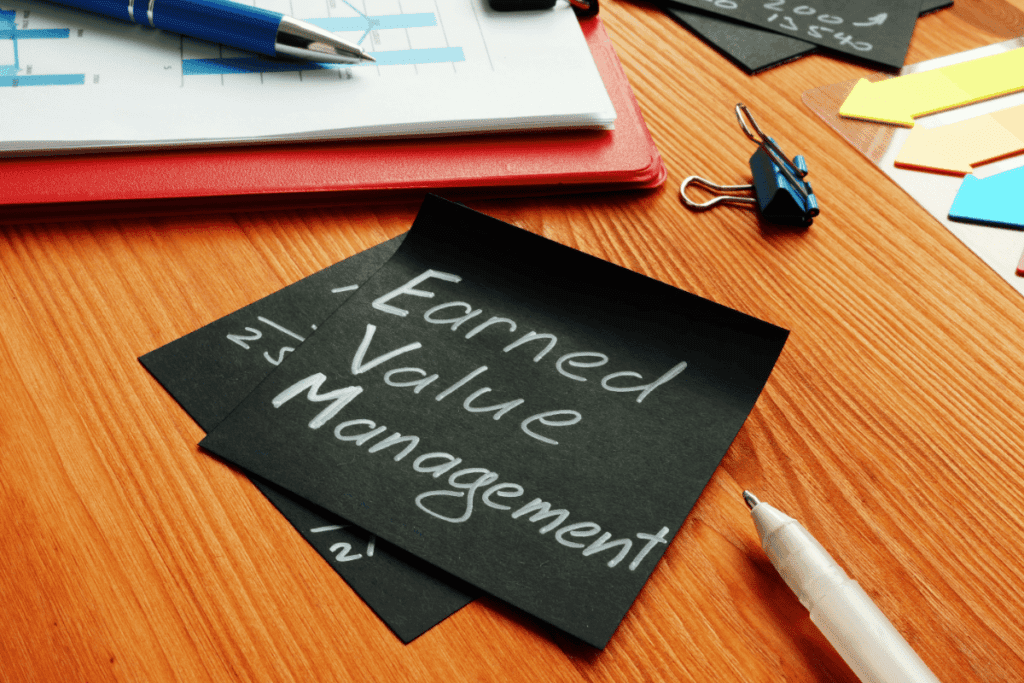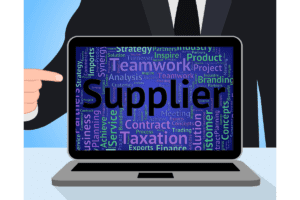What is Earned Value Management: How to Effectively Use EVM for Project Success
What is Earned Value? Why does it matter? Are your project deadlines constantly shifting, leaving you struggling to keep track of progress and costs? Earned Value Management (EVM) is a potent tool that enables greater control over project scope, schedule, and cost. It is the closest thing to a crystal ball for a Project Manager to predict a project’s success.
This article offers a deep dive into the core concept of EVM, how to calculate it accurately and use it effectively for achieving project success. Get ready to transform your approach to project management!
Key Takeaways
- Earned Value Management (EVM) tracks the progress and costs of a project. It helps to see if work is on time or late.
- The three key parts of EVM are Planned Value, Actual Cost, and Earned Value. They help managers make smart choices for their projects.
- Using EVM can warn you about future problems. If costs are going up fast, it could mean trouble later.
- There are some limits to EVM too. It needs good data to work well and it does not measure the quality of work done.
Understanding Earned Value Management (EVM)
Earned Value Management, or EVM, is a rigorous project management technique that helps managers measure project performance and progress in an objective manner.
What is Earned Value?
Earned value is the worth of work done in a project. It tells us how much of the budget we have used up to now. We often call it the “budgeted cost of work performed“. With earned value, a project manager can track if the project is within its budget.
It helps to see if we are using more or less money than planned at any point in time.
The History of Earned Value Management
Earned Value Management (EVM) originated in the 1960s as a financial analysis technique. It was developed primarily for the U.S. Department of Defense to manage complex military and aerospace projects. The goal was to provide a clear and quantifiable measure of project performance and progress, which was crucial for these high-stakes projects.
Adoption by the U.S. Department of Defense
The U.S. Department of Defense played a pivotal role in the formalization and standardization of EVM. They recognized its potential in improving project performance, particularly in terms of cost control and schedule management. EVM provided a more accurate and comprehensive view of project health compared to traditional management methods.
Expansion Beyond Military Projects:
EVM’s effectiveness in managing large-scale projects led to its adoption across various sectors. Industries such as construction, software development, and engineering began to implement EVM principles to enhance project management practices. This cross-industry adoption highlighted EVM’s versatility and effectiveness in diverse project environments.
Standardization and Legal Recognition
In the 1990s, EVM gained significant recognition. The American National Standards Institute (ANSI) established the ANSI/EIA-748 standard for EVM systems, which provided a framework for implementing EVM effectively. This standardization played a crucial role in its wider adoption.
In 1996, the Clinger-Cohen Act (also known as the Information Technology Management Reform Act) was enacted in the United States. This legislation mandated the use of performance-based management systems like EVM for certain types of federal government projects, particularly in IT.
Global Adoption and Current Usage
Over the years, EVM has been embraced globally by both public and private sectors. Its ability to provide objective, quantifiable data on project performance makes it a valuable tool for managing a wide range of project sizes and types. Today, EVM is not just a project management tool but a critical component of project management standards and best practices.
Professional organizations such as the Project Management Institute (PMI) have incorporated EVM principles into their body of knowledge, further endorsing its importance in the field of project management.
Core Concepts of Earned Value Management

Understanding the core concepts of Earned Value Management (EVM) is vital for successful project management. These primary elements include Planned Value (PV), which denotes the anticipated cost of project tasks, Actual Cost (AC), an actual expenditure incurred during project execution, and Earned Value (EV), a critical metric representing the value of work actually accomplished.
By mastering these components, you can monitor your project performance with more precision and make well-informed decisions to ensure its success.
Planned Value (PV)
Planned Value (PV) is key in tracking a project’s progress. It works as a guide for project managers. It starts with a firm project plan. This plan must have clear steps and goals, also known as a Scope Statement and Work Breakdown Structure (WBS).
PV keeps changing during the life of the project. Updates happen when there are changes to what the project needs, its timeline, or budget. To make smart choices for the project, managers use PV.
PV works hand-in-hand with two other values – Earned Value (EV) and Actual Cost (AC). Together they figure out money-based differences such as Cost Variance (CV) and how well costs perform which is Cost Performance Index (CPI).
Actual Cost (AC)
Actual Cost (AC) is the total money spent on a project till now. If a project has been running for five months, the AC will add up all costs from those five months. This cost includes all funds used in buying materials and paying workers among other things.
It helps to know how much you are spending for your work. Without knowing the AC, it might be hard to tell if you are going over budget or staying within it.
Earned Value (EV)
Earned Value (EV) tells us the value of work that has been done on a project. We often call this the “budgeted cost of work performed” or BCWP. EV helps us see how much our project has achieved at any moment in time.
To find out EV, we use planned costs for tasks that are finished already. If your plan said a task would cost $100 and it’s all done, its earned value is $100. Earned Value gives us a clear view of progress in terms of dollars or hours spent on a project.
How to Calculate Earned Value Management

Understanding the computation behind Earned Value Management is pivotal to its successful application. It begins with determining key variables, such as Planned Value (PV), Actual Cost (AC), and Earned Value (EV).
Following this, you can calculate Schedule Variance(SV) and Cost Variance(CV) to assess if the project is on time and within budget respectively. Additionally, indexes like Schedule Performance Index(SPI) and Cost Performance Index(CPI) provide ratios of efficiency in both schedule adherence and cost utilization.
Lastly, an estimate at completion(EAC) will give a holistic forecast about the final project cost based on current trends. Each calculation serves as a critical step towards comprehending your project’s health through EVM.
Schedule Variance (SV)
Schedule Variance (SV) is a key part of checking project progress. It shows if your work is on time or not. You can find it with a simple math problem: earned value (EV) minus planned value (PV).
SV will give you an amount in dollars. If this number is positive, good news! Your project is ahead of schedule. But, if the number is negative, then your project may take more time than you thought.
Using SV helps keep projects on track and makes sure no one falls behind.
Cost Variance (CV)
Cost Variance (CV) is key in the earned value management system. It helps you know how well a project sticks to its budget. CV shines a light on cost issues. To figure out CV, take away actual costs from the earned value of work done.
A positive CV tells us that the project spends less money than planned. But, a negative CV shows too much spending and hints at going over the project budget. This metric proves very useful for project professionals as it helps spot troubles with costs right away!
Schedule Performance Index (SPI)
The Schedule Performance Index (SPI) is a vital part of Earned Value Management. It helps project managers see if the project is on time or late. To get the SPI, we divide the Earned Value (EV) by the Planned Value (PV).
The result tells us about our project schedule. It measures whether the project is behind schedule or on track to succeed.
A SPI value of 1 or more is good news! It means your project goes along as planned or even faster. But, if you get an SPI less than 1, it shows that your work lags behind schedule.
Tracking and watching over SPI lets you steer your project in time to meet its end-date.
Cost Performance Index (CPI)
The Cost Performance Index or CPI is a big deal in project management. It tells us how well we are using the money for a project. To find out the CPI, divide Earned Value (EV) by Actual Cost (AC).
A CPI of 1 or more is good news! This means you are staying on budget or doing even better. But if your CPI is less than 1, that’s not so great. It means you’re spending more than planned on your project.
By keeping an eye on the CPI, managers can make smart decisions and keep costs under control. So, it’s clear to see – knowing your CPI helps keep projects successful!
Estimated At Completion (EAC)
The EAC is a key tool in project management. It tells you what the total cost of your project will likely be when it’s done. You should check on this number often, maybe every month or so.
This helps you see if any big changes have taken place that may affect your budget or timeline. A full EAC report should be made each year or after large events on the project to make sure everything is still going as planned.
Not just whole projects, but smaller parts like Control Accounts and Work Packages can also have their own EACs prepared for them. The person in charge of all this is usually called the Control Account Manager (CAM).
The Role of Earned Value Management in Project Management

Earned Value Management (EVM) is a vital tool in project management. It helps managers keep track of the project’s progress. EVM shows us how much work has been done and how much money we have spent.
This system also tells if the project is running on time or late. If costs are low, high, or just right according to the plan, EVM will show it all. This makes it easier for managers to steer the course of their projects.
In addition, EVM can predict future problems as well. For instance, if costs are rising too fast compared to work done, it could mean trouble ahead. Managers can spot such issues early with EVM and take action before they become big problems.
Essential Elements of EVM
Earned Value Management (EVM) has three key parts. The first one is Planned Value (PV). This shows how much work you should have done at a certain time. The second is Actual Cost (AC).
It tells us what was really spent on the work. The last part is Earned Value (EV). EV shows the real value of the work that’s been done.
Good planning and tracking are also needed for EVM. Your project plan should have clear goals, tasks and costs. Then, keep track of how your team works toward these goals each day or week to see if you are on track.
Limitations of Earned Value Management
While EVM offers valuable insights for project management, it does have some limitations. The quality of reporting depends heavily on the accuracy and reliability of underlying data.
Additionally, the method doesn’t fully align with Agile projects due to its focus on planning up front. Lastly, EVM lacks a clear measure for assessing project quality – an aspect that’s crucial for overall project success.
Reporting is only as good as the underlying data
Data is the heart of any report. If the data is wrong, your report will be too. You need to check your data carefully. Make sure it’s right before you put it in your report. This makes sure that your earned value management reports are helpful and accurate.
They can then guide good choices for your project.
The process has limited use for Agile projects
Agile projects change often. They need quick changes in scope and cost. The Earned Value Management process is not good for this. It works best with plans that do not change a lot.
Agile teams can’t use it well because their work keeps changing.
There’s no measure for quality
Earned Value Management (EVM) does not measure the quality of work. It tracks time and money spent on a project. But, it can’t tell if the work done is good or bad. This is a big limit to EVM.
A project may be on time and within budget. But, if the work is poor, problems will come up later on. These issues may cost more time and money to fix than planned at first. So, while EVM helps with managing costs and schedule, it doesn’t look at the quality of work being done.
Steps to Measure Earned Value Management for Project Performance

To measure Earned Value in Project Management, you need to follow some steps. First, set up your project plan. This includes a Scope Statement and Work Breakdown Structure (WBS). They tell what work the project will do.
Next, you build a budget. This becomes part of your project baseline. You have to know the cost of each task in your WBS. Then you can find out the total planned value of your project.
Now start working on the tasks! As work gets done, keep track of actual costs. Use these numbers to figure out earned value (EV). This is how much each task was worth based on its planned cost.
As you move through your project, compare how things are going to how they were planned to go. Look at schedule variance and cost variance too!
The Schedule Performance Index (SPI) shows if the project is ahead or behind schedule.
If SPI is greater than 1, good news! Your team has done more work than planned in that time period. If it’s less than 1? The team fell behind.
The Cost Performance Index (CPI) helps see if you’re over or under budget.
If CPI is less than 1 then we’ve spent more money than expected on our tasks so far – we’re over budget.
These steps give an idea about earned value measurement for projects using EVM techniques! We can use them again and again during projects for better planning and control!
Best Practices for Using Earned Value Management
First, always start with a strong project plan. You need to know the full scope of your work. Create a Work Breakdown Structure (WBS). This shows all tasks in your project and helps you track them.
Next, calculate Planned Value (PV), Earned Value (EV), and Actual Cost (AC) often. These numbers show how well you are doing on time and budget.
Use this data to spot problems early. If costs are too high or progress is slow, take action right away. Don’t wait until the end of the project! Also, keep an eye on quality while tracking cost and schedule.
High-quality work adds more value than just staying on budget or finishing on time.
Train your team in Earned Value Management (EVM). Everyone should understand the basic concepts like EV, PV, AC etc., as they relate to their tasks. Finally; use tools that support EVM for easier calculations and clearer reviews of progress made in terms of cost performance index or schedule performance index values.
FAQs
1. What is earned value management in project performance?
Earned Value Management, or EVM, is a way to measure project performance. It uses formulas and calculations to track the progress of a project.
2. How can I use earned value in my projects?
Project managers use EVM to calculate planned values and actual costs. These numbers help them know if their project is ahead of schedule or behind schedule.
3. Can earned value management system also work on budgets?
Yes! Besides schedules, an Earned Value Management System (EVMS) lets you track your budget too! You will know if your project is under budget or over budget.
4. Is there more than one formula used in earned value analysis?
Yes! There are many formulas used for different tasks like calculating Schedule Variance(SV), Cost Performance Index(CPI), and others needed for Earned Value Analysis (EVA).
5. Does using EVM need any special software?
Not always, but some people find it helpful to use project management software that has tools built-in for things like cost tracking or even creating work breakdown structures.
6. Are there benefits of using EVM outside the scope of cost and time tracking?
Sure! Although mostly used for managing costs and timelines, EVM can also help evaluate current performance which facilitates risk management by showing what parts might not be working as planned.
Conclusion
Earned Value Management (EVM) helps you keep your project on track. It shows if you are under or over budget and ahead or behind schedule. With EVM, you can see problems early and fix them.
This way, every project can have a good end result.
If you liked this article, remember to subscribe to MiamiCloud.com. Connect. Learn. Innovate.






